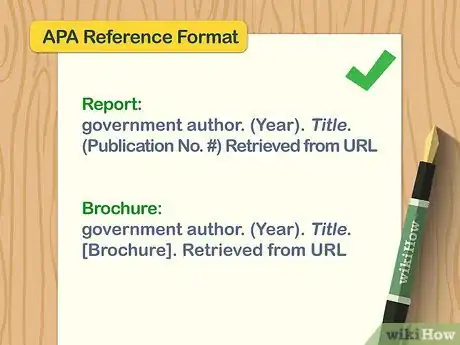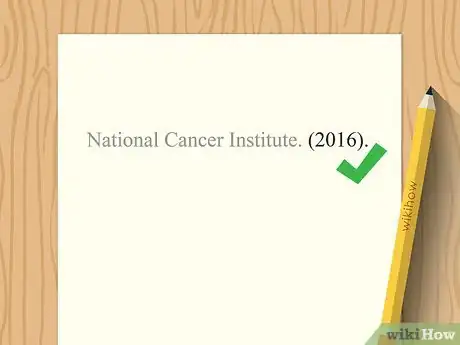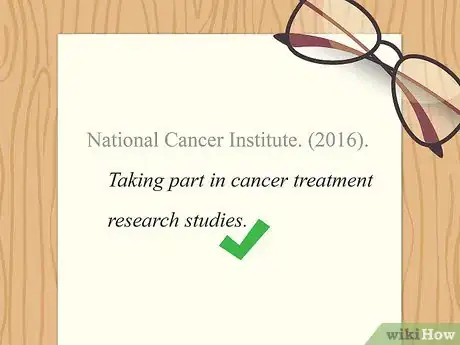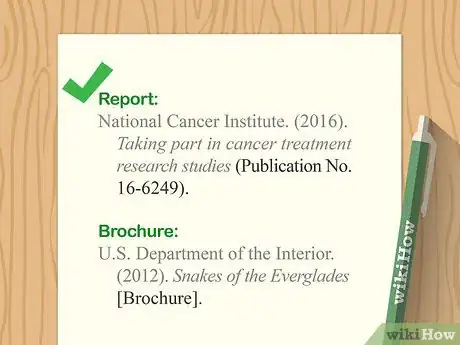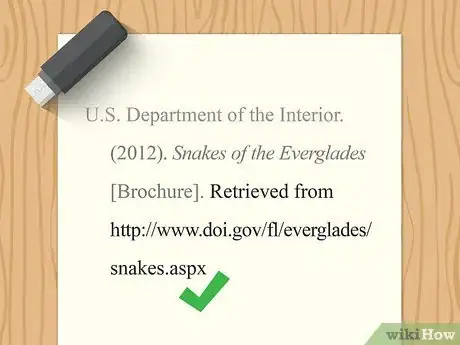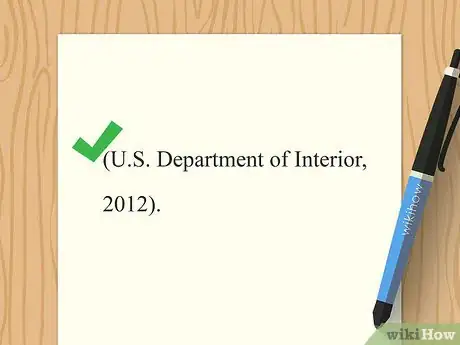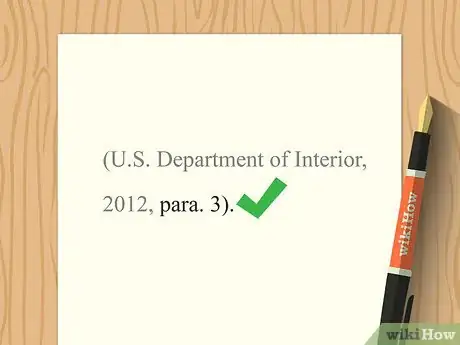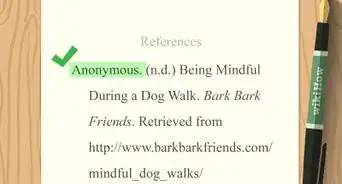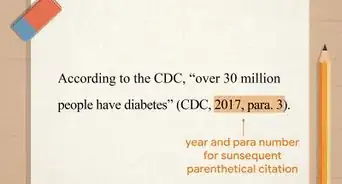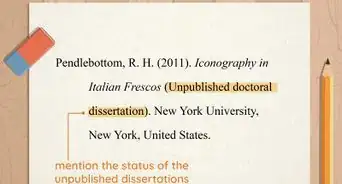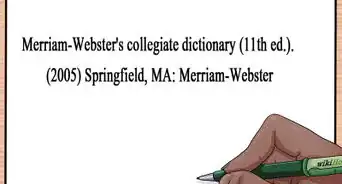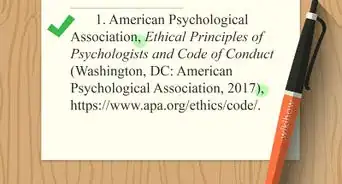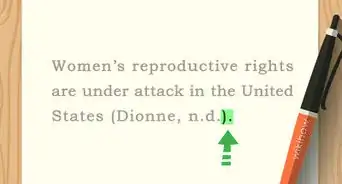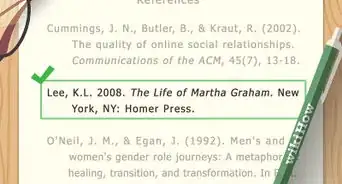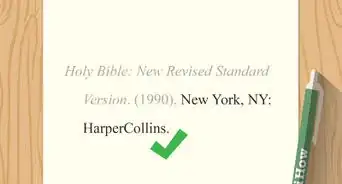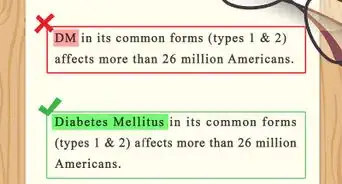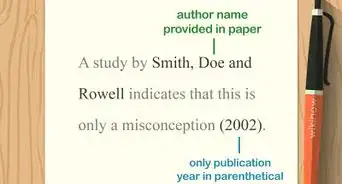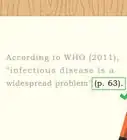This article was co-authored by wikiHow staff writer, Jennifer Mueller, JD. Jennifer Mueller is a wikiHow Content Creator. She specializes in reviewing, fact-checking, and evaluating wikiHow's content to ensure thoroughness and accuracy. Jennifer holds a JD from Indiana University Maurer School of Law in 2006.
There are 9 references cited in this article, which can be found at the bottom of the page.
This article has been viewed 27,813 times.
Learn more...
When you're writing a research paper, American Psychological Association (APA) style requires you to cite your sources in two ways. The entry in your Reference List at the end of your paper provides full publication information that will allow readers to locate the source and read it themselves. A parenthetical in-text citation points the reader to the full entry in the Reference List. APA style does not have a distinct category for government publications. If you use a government website as a source, you would generally use the same format as you would use for any other website. However, if you're citing a report or brochure available on the website, your format will be somewhat different.[1]
Steps
Reference List Entry
-
1Start with the government author. Even if an individual is listed as the author, for a government document, the government agency is considered the author of the report. Use the full name for the agency, not an abbreviation. For example, you would type "Internal Revenue Service" instead of IRS. Place a period at the end of the agency's name.[2]
- Example: National Cancer Institute.
Tip: While government agencies often list a hierarchy of departments, you only need to include the name of the most specific responsible agency. For example, you would use "National Cancer Institute" instead of "U.S. Department of Health and Human Services, National Institutes of Health, National Cancer Institute."
-
2Provide the year of publication in parentheses. Type a space after the period that follows the name of the government agency, then provide the year the document was published. This date should be on the document itself. Do not use the general copyright date for the overall website. Place a period outside the closing parenthesis.[3]
- Example: National Cancer Institute. (2016).
Advertisement -
3Include the title of the document in italics. After the year of publication, type the full title of the document in sentence-case, capitalizing only the first word and any proper names. If there is a subtitle, place a colon after the title and type the full subtitle, also in sentence-case.[4]
- Example: National Cancer Institute. (2016). Taking part in cancer treatment research studies
-
4Identify the type of document. If the document is a report, it will typically have a report or number. This may also be called a publication number or document number. Type that information in parentheses after the title, exactly as it is formatted on the report. If the document is a brochure, simply type the word "Brochure" enclosed in square brackets. Place a period at the end, outside the closing punctuation.[5]
- Report example: National Cancer Institute. (2016). Taking part in cancer treatment research studies (Publication No. 16-6249).
- Brochure example: U.S. Department of the Interior. (2012). Snakes of the Everglades [Brochure].
-
5Close with the URL where the document can be found. Type the words "Retrieved from," then copy the full, direct URL for the document. Do not place a period at the end of the URL. For documents uploaded onto a government website, it isn't necessary to include the date you accessed the document.[6]
- Report example: National Cancer Institute. (2016). Taking part in cancer treatment research studies (Publication No. 16-6249). Retrieved from https://www.cancer.gov/publications/patient-education/CRS.pdf
- Brochure example: U.S. Department of the Interior. (2012). Snakes of the Everglades [Brochure]. Retrieved from http://www.doi.gov/fl/everglades/snakes.aspx
In-Text Citation
-
1List the name of the government author first. At the end of any sentence in which you paraphrase or quote the government document, include a parenthetical citation inside the sentence's closing punctuation. Start with the name of the agency exactly as it appears in your Reference List entry. Place a comma after the agency's name.[7]
- Example: (U.S. Department of Interior,
Exception: APA style allows you to use an abbreviated version of the government author in your text if you're mentioning the agency often. In that case, you can also use the abbreviation in your parenthetical citation.
-
2Provide the year the document was published. After the name of the agency, include the year of publication for the document. This concludes your parenthetical citation if you're citing a paraphrase. Place a period outside the closing parenthesis.[8]
- (U.S. Department of Interior, 2012).
-
3Include the page or paragraph number for direct quotations. If you're citing a government document that was uploaded to a government website, it typically will have page numbers. If not, use paragraph or section numbers to let your reader know where the specific quote appears.[9]
- For example, you might write: Invasive Burmese pythons are blamed for the decline of native small mammal populations because they "have been regularly found in the stomachs of Burmese pythons" captured in and around the Everglades (U.S. Department of Interior, 2012, para. 3).
-
4Omit parenthetical citations if the information is included in your text. A separate parenthetical citation isn't necessary if you include the information in the body text of your paper. Using these signaling words instead of parenthetical citations can enhance the readability of your paper.[10]
- For example, you might write "A 2012 study by the U.S. Department of Interior noted the raccoon population of the southernmost region of Everglades National Park has decreased by 99.3 percent since 1997."
- If you include the name of the agency in your text, place the year of publication in parentheses immediately after the name of the agency. For example, you might write "According to the U.S. Department of Interior (2012), invasive Burmese pythons have eradicated or nearly eradicated many species of native mammals, including marsh rabbits, cottontail rabbits, raccoons, and foxes."
References
- ↑ https://guides.himmelfarb.gwu.edu/c.php?g=27779&p=170369
- ↑ https://blog.apastyle.org/apastyle/2018/09/how-to-cite-a-government-report-in-apa-style.html
- ↑ https://owl.purdue.edu/owl/research_and_citation/apa6_style/apa_formatting_and_style_guide/reference_list_electronic_sources.html
- ↑ https://libguides.up.edu/apa/websites
- ↑ https://columbiacollege-ca.libguides.com/apa/governmentdocs
- ↑ https://nwtc.libguides.com/citations/APA7
- ↑ https://blog.apastyle.org/apastyle/2018/09/how-to-cite-a-government-report-in-apa-style.html
- ↑ https://columbiacollege-ca.libguides.com/apa/websites
- ↑ https://guides.libraries.psu.edu/apaquickguide/intext
